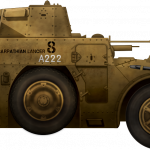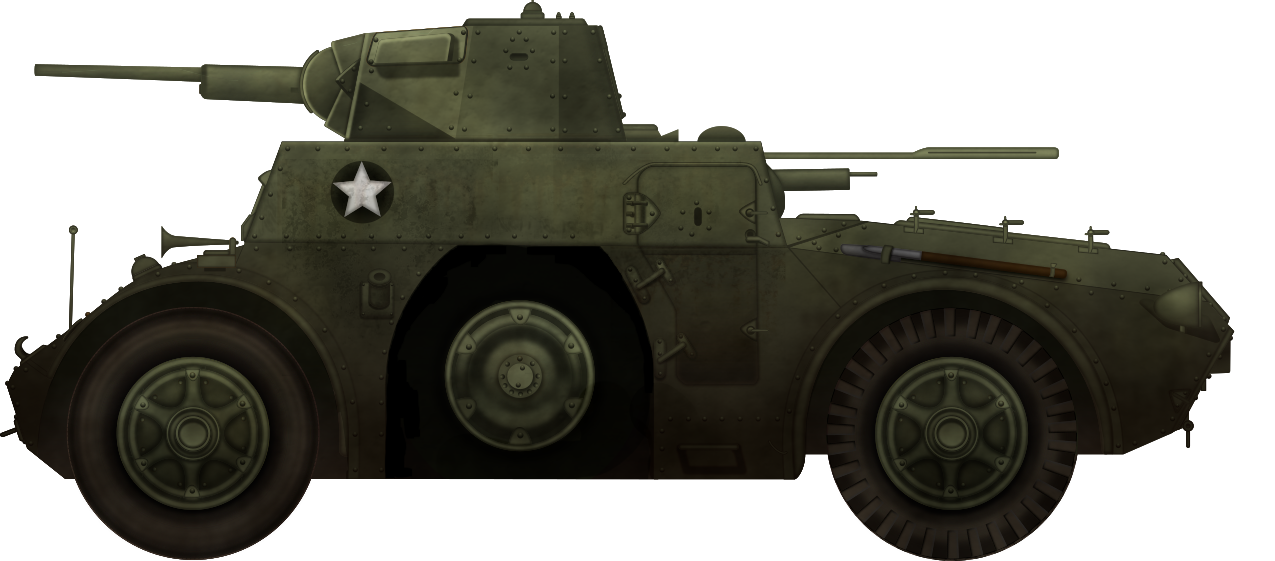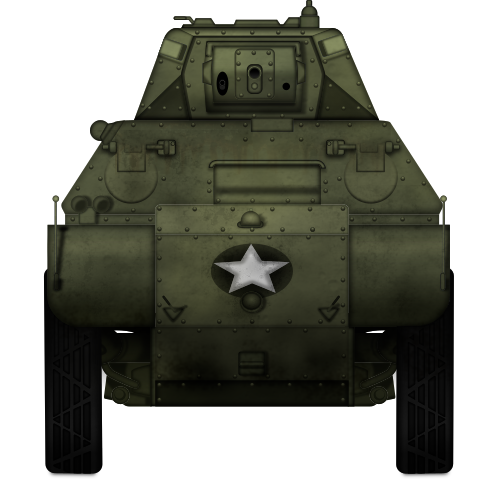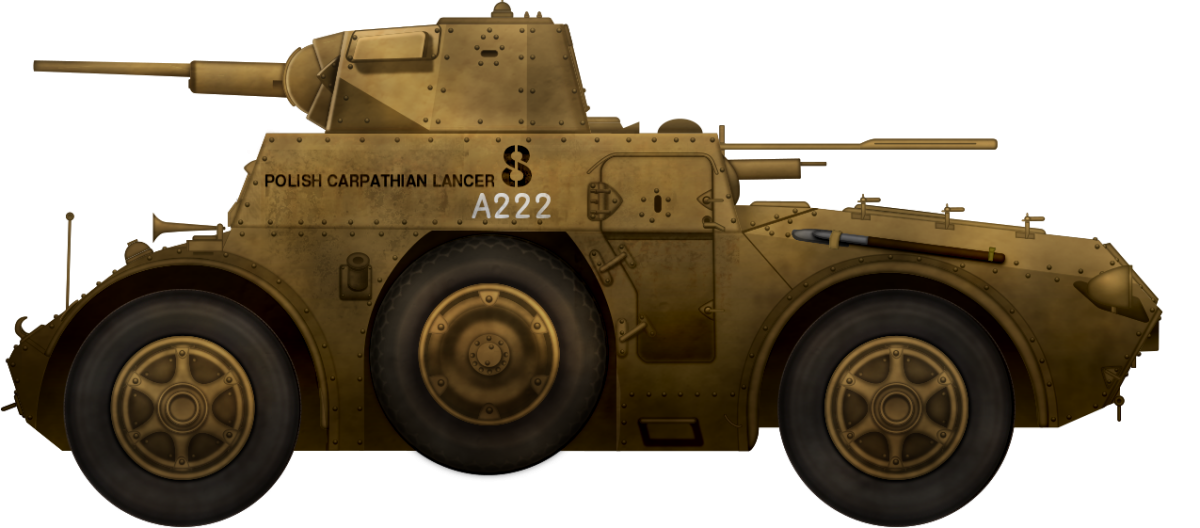
 United Kingdom/United States of America (1941-1943)
United Kingdom/United States of America (1941-1943)
Medium Armored Car – Unknown Number in Allied Service
The Autoblinda AB41 was an Italian medium reconnaissance armored car used during the whole duration of the North African campaign, mainly deployed by the Italian Regio Esercito (English: Royal Army) and by the Polizia dell’Africa Italiana or PAI (English: Italian African Police). During this campaign, many German and Italian vehicles fell into Allied hands, including, among others, Australian, British, Free French, Polish, and South African units. After Operation Torch, when the Allied forces attacked the Axis in North West Africa in early November 1942, they captured a number of AB41s and redeployed them.

Italian Vehicles in Allied Service
Unsurprisingly, the AB41 was not the only Italian armored vehicle to be put into service with Allied forces. For instance, six Carri Armati M11/39 and an unknown number of Carri Armati M13/40 were used by the Australian 2/6th Cavalry Regiment and the British 6th Royal Tank Regiment, until spring 1941, when they ran out of spare parts and they were destroyed.

One of the most used vehicles in North Africa by the Italians was the Autoblinda AB41 armored car that, in addition to performing reconnaissance tasks, was also used as a vehicle to support infantry assaults. In fact, thanks to its protection and armament, it could perform the support task with success if the enemy forces were only equipped with light weapons.
The unquestionable fame of the vehicle made it an interesting vehicle for Commonwealth and Allied troops to reuse it after capture.
Design

The AutoBlinda Modello 1940 was the first of the AB medium reconnaissance armored car series. It had two driving positions, at the front and at the rear. This feature was designed to permit the armored car to disengage from skirmishes even on narrow mountain roads or in the dense North African villages.

The armor on the entire hull, superstructure, and turret consisted of bolted plates. This arrangement did not offer the same efficiency as mechanically welded plates, but facilitated the replacement of an armor element in case it had to be repaired. The hull plates were bolted onto an internal frame.

There were 4 crewmembers: the front and rear drivers, a commander/gunner, and the rear machine gunner. The engine was a petrol FIAT-SPA ABM 1, 6-cylinder in-line with an internal volume of 4,995 cm3. It had a 78 hp (some sources mention 80 hp) output at 2,700 rpm. The maximum speed was 76.4 km/h. In the rear driving position, the driver could use only 4 of the 6 gears with a maximum speed of 36.4 km/h.

Influenced by the experiences gained in the Spanish Civil War, the Regio Esercito’s High Command ordered a more potently armed version of the AB40. For this, the Torretta Modello 1941 (English: Turret Model 1941) of the Carro Armato L6/40 (English: L6/40 Tank) was mounted. It was armed with a Cannone-Mitragliera Breda da 20/65 Modello 1935 (English: 20 mm L/65 Automatic Cannon Breda Model 1935) with a coaxial Breda Modello 1938. A second machine gun in a spherical support on the vehicle’s rear, on the left of the rear driver.

With 667 built, the AutoBlinda Modello 1941 (English: Armored Car Model 1941), or, more simply, AB41 Medium Armored Car, was the most produced Italian armored car of the Second World War.

The designers planned for the new Autoblinda AB41 to be equipped with a FIAT-SPA ABM 2 engine. At 88 hp at 2,700 rpm, it was more powerful than the previous ABM 1. This allowed for a maximum velocity of 78.38 km/h in the 6th gear and 37.3 km/h in the 4th gear. Due to delays in producing FIAT-SPA ABM 2 engines, a total of 435 ABs with Torretta Modello 1941, up to the vehicle with license plate Regio Esercito 551B, were equipped with the FIAT-SPA ABM 1 engine of the AB41. The vehicles with different engines are impossible to distinguish from the outside and are considered AB40 and AB41 hybrids.

The AB series armored cars were equipped with a powerful 60 km range radio with a 7 m fully-extended antenna on the left side.

Allied Operational Use
Some AB41s were captured by Commonwealth troops during the North African campaign (10th June 1940 – 13th May 1943). The British Army supplied some of these armored cars to Australian and Polish forces.
Perhaps the most famous use was the Autoblinda AB40/AB41 hybrid of the Polish Independent Carpathian Rifle Brigade. It had most probably been captured from the III Gruppo Autoblindo ‘Nizza’ (English: 3rd Armored Car Group) at some point after March 1941. Contrastingly, the book Italian Armored Cars Autoblindo AB41 & AB43, Pz.Sp.Wg AB41 201(i) & AB43 203(i) written by Daniele Guglielmi, mentions that the armored car was captured from the Polizia dell’Africa Italiana. This seems to be incorrect, as the coat of arms of the IV Plotone Autoblindo (English: 4th Armored Car Platoon) of the III Gruppo Autoblindo ‘Nizza’ is seen painted on the right side of the armored car in a contemporary propaganda video.

The armored car was used alongside Marmon-Herrington armored cars against its former owners and the Germans in Egypt between May and August 1942. After that, it was requisitioned by the British High Command.

The Autoblinda AB41 of the Polish Independent Carpathian Rifle Brigade was probably not the only AB41 captured and reused by Allied troops, even if no concrete information has emerged. Many Italian sources mention that two Autoblinde AB41 armored cars were sent to Chobham, in Surrey, England, although British reports mention only one armored car tested.
Some of the AB series armored cars that were used by France post-war to regain control of its colonies were delivered by British or other Allied forces in North Africa after the end of the North African campaign. It is known that French forces deployed at least 10 and probably more AB41s after the war, so, this could be a partial number of AB41s in service with the Commonwealth forces in North Africa during the last stages of the campaign.
From British veterans’ memoirs, an unknown, but limited number of Italian captured vehicles were used by British forces in training camps located in Egyptian territories. They were used to familiarize British soldiers with enemy vehicles. It seems that even few AB41s were deployed to teach their armored car crews to train to drive and fight Italian armored cars. Sadly, no photographic evidence has been found.
An AB41 is exhibited at the South African National War Museum in Johannesburg alongside other Second World War-era Allied and Axis vehicles and Cold War-era NATO and Soviet vehicles. How and why the vehicle arrived in South Africa is not known, even if it is probable that this vehicle was captured by Commonwealth troops, used for training in Egypt, and that it arrived in South Africa only after the end of the war.
The US Army also used some captured Autoblinde AB41s when they entered the war in North Africa in November 1942. At least two were captured and deployed in Tunisia but further details of their operational history are unknown. Only one image of these vehicles is known. The US vehicles were repainted in the common olive drab painting and received white stars for aerial recognition on the front and sides.

The British School of Tank Technology Report
In May 1943, Major J. D. Barnes and Major D.M Pearce published a detailed report of a captured AB40 armored car with a Modello 1941 turret that had been transported to the United Kingdom and thoroughly inspected at the School of Tank Technology of Chobham. The vehicle was the one previously belonging to the Polish Independent Carpathian Rifle Brigade.
At some point between March 1941 and the first months of 1942, the British High Command decided to take the armored car of the Polish Independent Carpathian Rifle Brigade and transport it to Britain for evaluation. The AB41 was perhaps withdrawn from the frontline in August 1942, then sent to the rear lines, probably a harbor in Egypt or Palestine, before being sent to the United Kingdom, where it was analyzed by the School of Tank Technology 9 months later.
The analysis revealed it was built in 1941 and had the chassis number ‘40788’ and had the ‘ABM40’ name on the chassis plaquet. The engine had production code ‘100041’ and was built on 21th November 1940.
The first note in the report was about the status of the vehicle when it arrived in Chobham:
“The car arrived in this country in good condition. This is accounted [sic] by the comparatively small mileage covered, and by the considerable troubles taken to protect components from corrosion or damage during transit. After a few minor adjustments the car was made a runner, and mechanically it appeared to be fairly sound with the exception of the steering which needs some attention.”
From photographic evidences it is possible to determine that it was equipped with 3 Pirelli Tipo ‘Libia’ tires (front axle and rear left ones) and 3 Pirelli Tipo ‘Sigillo Verde’ tires (rear right axle and spare wheels) even if British report claimed 4 Tipo ‘Libia’ and 2 “heavy duty” tires or Tipo ‘Sigillo Verde’. These were two Italian low pressure tires developed for sandy soils. The first type was developed for armored vehicles, while the latter type was developed for the Camionette Desertiche (English: Desert Scout Car) SPA-Viberti AS42 ‘Sahariana’ but used on various vehicles with the same rim sizes, including the armored cars of the AB series.


The all-wheel steering and al-driving wheels were praised:
“Mechanically the car has many interesting and certain commendable features. The distributed drive to all four wheels and the four wheel steering, make it possible to use a single differential at the expense however of a very large number of bevel gears.”
The British appreciated the dual driving position, but listed a number of shortcomings. They reckoned that the directional control lever that permitted the front driver to take control of the vehicle was in an awkward position and that the rear driver’s seat did not allow tall soldiers to seat comfortably.
“While the general mechanical layout appears to have been well thought out and designed specially for the job, the mechanical details in certain cases contrast strikingly in their inadequacy or shoddyness. The whole construction and layout of the rear driver’s section savours of modification or afterthought. The main petrol tank under the floor is only protected by a light gauge tray and is extremely inaccessible. The forward tank feeds into the main tank by gravity and no stop cock is provided in the line. There are other similar examples of bad design.”
The British technicians were less enthusiastic about the armament and its positions on the armored car.
“With regards to the armament and armour, it is noticeable that again the lack of attention paid to detail design considerably reduces the potency of the car as a fighting vehicle. The one man turret does not conform to the latest British requirement for a three man turret. The exposed traverse gears, the akward position of the 2 cm. cocking handle and the limited observation in the turret are in our opinion decidedly undesirable feature: There is no electrical equipment in the turret and consequently no rotary base junction. The commander is therefore faced with the problem of what to do with his headphone and microphone leads when travelling the turret.”

The rear machine gun position was considered to have various deficiencies.
“It is impossible to sight the rear hull gun when it is fully depressed and extremely difficult to do so at any angle under zero. The gunner’s seat is not in line with the gun and he must lean awkwardly in order to sight when the gun is traversed left. His back is fouled by the turret gunner’s seat when the turret is straight ahead or traversed left. These points and the improvised appearance of the gun mounting suggest the possibility that the rear hull gun was added as an afterthought.”
The engine was judged adequate by the front line soldiers, even if the British considered it difficult to maintain, due to the presence of brackets for the armored plates that were welded to the hull frame, which limited accessibility in the engine compartment. Interestingly enough, Italian crews never reported this as a problem.
During driving tests, the British noticed that the first 4 gears were noisy and it was difficult to change them. The last two gears were not as noisy and were easier to change. The engine performed perfectly at slow speeds and was considered quiet from the front driver’s position, even if the vehicle did not have a bulkhead. The engine was found to be noisier from the rear driver’s position, and due to the absence of a bulkhead, part of the engine’s fumes entered the crew compartment. During the driving, it was noticed that at 24 km/h, the vehicle tended to glide with a swaying motion. At 32 km/h, the armored car was almost uncontrollable.
The hydraulic brakes were found easy to operate but, for maintenance reasons, were not very effective. The independent suspension was judged excellent during off-road and on-road driving and it provided the crew with great comfort. The spare wheel’s position was also praised. This was a common feature on AB series armored cars and it permitted the spare wheels to help the vehicle to overcome obstacles during off-road driving, and at the same time, avoiding ‘bellying’ on rough terrains.
The armor was considered to be badly bolted to the superstructure with dangerous gaps between the armored plate and the structure on which these were bolted.
“The fitting of the plates is generally bad, and even in such exposed positions as the nose, considerable gaps occur between the plate edges. Very little attempt has been made to protect the crew against bullet splash. Turret ring protection is provided only at the rear by a length of 6 mm. angle section bolted to the top plate.”
During a test done by British technicians of the School of Tank Technology with a Poldi portable tester, Brinnel hardness was registered between 320 BHN and 340 BHN, harder than the Italian tank’s armor. These Brinell results showed this Italian armor used on the armored cars to be quite similar to US armor, which had a hardness of 280-320 BHN, and far softer than the 413-460 BHN of Soviet steel.
The abbreviation BHN – Brinell Hardness Number (unit of measurement kg/mm²) is a figure used to determine the hardness of a material from a hardness test. The harder a steel is, then generally, the better it will be at resisting shell impacts, but also more vulnerable to shattering.

The Autoblinda AB41 tested at Chobham was scrapped probably shortly after the tests concluded, in fact, it was never again mentioned in British reports.
Recognition Pictorial Manual on Armored Vehicles – Italy
On 3rd November 1943, the US Army War Department published the Recognition Pictorial Manual on Armored Vehicles – Italy, which briefly described the Autoblinda AB41’s main features: double drive, all steering and all driving wheels, the presence of spare wheels free to rotate, and a maximum velocity of 49 mph (78 km/h) with front driving and 24 mph (38 km/h) with rear driving. The vehicle that they analyzed at the Aberdeen Proving Ground was probably captured during the Sicily campaign in May-June 1943. The US technicians did not analyze it as thoroughly as the British, and after a short time, scrapped it.
Conclusion
Despite the School of Tank Technology’s not very positive final judgment on the Autoblinda AB41, some Allied units reused several in North Africa. It was fast, with great off-road capabilities, adequate protection, and armament to combat against other Axis reconnaissance vehicles. At least one or two vehicles captured were sent to the School of Tank Technology in the United Kingdom and another to the Aberdeen Proving Ground in the United States.



Autoblinda AB41 Specification |
|
|---|---|
| Size (L-W-H) | 5.20 x 1.92 x 2.48 m |
| Weight, battle ready | 7.52 tonnes |
| Crew | 4 (front driver, rear driver, radio operator/machine gunner and commander/gunner) |
| Engine | FIAT-SPA 6-cylinder petrol, 88 hp with 195 liters tank |
| Speed | 80 km/h |
| Range | 400 km |
| Armament | Cannone-Mitragliera Breda 20/65 Modello 1935 (456 rounds) and Two Breda Modello 1938 8 x 59 mm machine guns (1992 rounds) |
| Armor | 9 mm Hull Turret: Front: 40 mm Sides: 30 mm Rear: 15 mm |
| Production | 667 in total, unknown number in Allied service |
Sources
Preliminary Report on Italian Armored Car Autoblinda 40 – Major J. D. Barnes and Major D.M Pearce – May 1943
Gli Autoveicoli da Combattimento dell’Esercito Italiano, Volume II, Tomo I – Nicola Pignato and Filippo Cappellano – Ufficio Storico dello Stato Maggiore dell’Esercito – 2002
Italian Armored Cars Autoblindo AB41 & AB43, Pz.Sp.Wg AB41 201(i) & AB43 203(i) – Daniele Guglielmi – Armor PhotoGallery #8, Model Centrum PROGRES – 2004
Le Autoblinde AB40 AB41e AB43 – Nicola Pignato and Fabio d’Inzéo – Modellismopiù.com


3 replies on “Autoblinda AB41 in Allied Service”
How can you tell the difference between regular AB41 and AB40 with mod.41 turret?
From the outside? You can’t
cool would be nice if war thunder added it